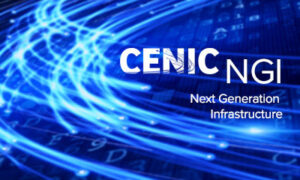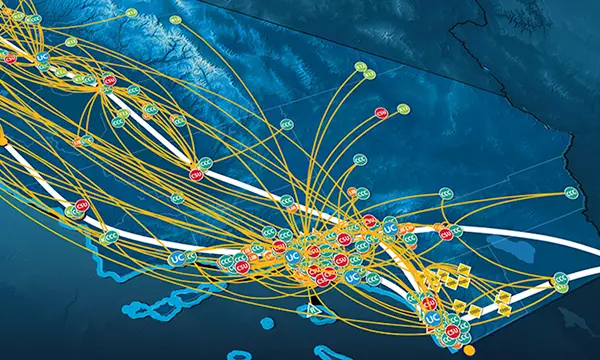- About
- Network
- Community
- Initiatives
- News
- Events
- Blog
- Publications

CENIC’s Next Generation Infrastructure To Deliver Additional Capacity, Flexibility, Services
Categories RENS & NRENS
CENIC is implementing Next Generation Infrastructure (NGI) across all 17 major CENIC hub sites in California to support its members growing and evolving needs.
An effort to modernize CENIC’s California Research and Education Network (CalREN), NGI will enable greater network capacity, flexibility, and resiliency; more efficient and environmentally friendly use of resources; and access to additional cloud computing and other on-demand solutions.
CENIC’s NGI includes:
- State-of-the-art optical, core, and service edge equipment deployed on CENIC’s fiber-optic backbone,
- 100-Gigabits per second to 800-Gbps optical channels, with up to 34 Terabits per second of spectrum capacity per optical span,
- A scalable switching core architecture coupled with a programmable services edge to facilitate high-speed data movement,
- Services that monitor and measure the network around the clock to ensure it is operating at peak performance, and
- Advanced cybersecurity capabilities to assist connected sites in the event of a Distributed Denial of Service (DDoS) attack.
CENIC engineers are completing major upgrades such as consolidation of High-Performance Research (HPR) and Digital California (DC) hardware, which enables the flexibility for our members to use their circuits as DC, HPR, or both, and deployment of multiprotocol label switching (MPLS), a routing technique that improves scalability, performance, efficient bandwidth utilization, and end-user experience.
CENIC’s Layer 1 Next Generation Infrastructure consists of an optical ring of 8,000 miles of fiber covering California’s coastal, inland, and southern paths with 27 add/drop service locations. CENIC’s NGI line system uses flexible grid technology and is extendable to support colorless, directionless and contentionless (CDC) technologies. CENIC can deliver 10 Gbps, 100 Gbps, 200 Gbps and 400 Gbps capabilities, and will soon add spectrum as a service.
Benefits of Layer 1 NGI include:
- Increased provisional bandwidth over existing fiber spans
- Lower operational costs to deliver 100 Gbps services
- A vendor-agnostic, open line system
- Zero-touch provisioning of optical circuits
- Reduced space and power needs
CENIC’s Layer 2 and Layer 3 NGI uses leading-edge technologies such as Segment Routing, MPLS, Ethernet Virtual Private Network (EVPN), Border Gateway Protocol Prefix Independent Convergence (BGP PIC), and Topology Independent Loop Free Alternate (TI-LFA) to provide new services giving customers additional flexibility.
Benefits of Layer 2 and 3 NGI include:
- Increased flexibility for customers to extend their network
- Access to additional services and peers
- Greater resiliency and faster convergence
- Efficient use of equipment
- Automated service deployments
- Granular control of network traffic
NGI at the scale of CalREN is a complex and substantial endeavor, requiring many highly skilled individuals of CENIC’s engineering and operations teams to research, evaluate, select, architect, deploy, and operationalize. CENIC engineers began work on NGI in 2018 and have worked diligently on the effort despite increased obstacles due to the pandemic. CENIC engineers rose to the challenge of collaborating remotely, adapting to logistical issues such as shipping, and working with vendors through product shortages. Work on NGI is slated for completion by early 2022.
Next Generation Infrastructure ensures CENIC can easily meet today’s networking demands while remaining flexible to meet the needs of tomorrow. These upgrades provide CENIC’s members a more robust and efficient network on which to conduct data-intensive research, support teaching and learning, provide cutting-edge medical care, and enhance community engagement.
Related blog posts
The Big Game Is Big Data: How CENIC and the California Research and Education Network Support Member Athletics
When Fresno State needed to connect to Pac-12 Enterprises to broadcast a live football game over CBS, the Chancellor's Office reached out to CENIC for what Pac-12 later called the smoothest turn-up they've ever experienced.
Enabling Network-Based Collaboration Around the World: A Tour of CENIC and Partner Network Maps
On the Network Maps page at the CENIC website, you’ll find maps of all the networks, peering facilities, and exchanges to which CalREN connects, showing how thousands of CENIC member institutions connect to CalREN and to colleagues all over the globe.


